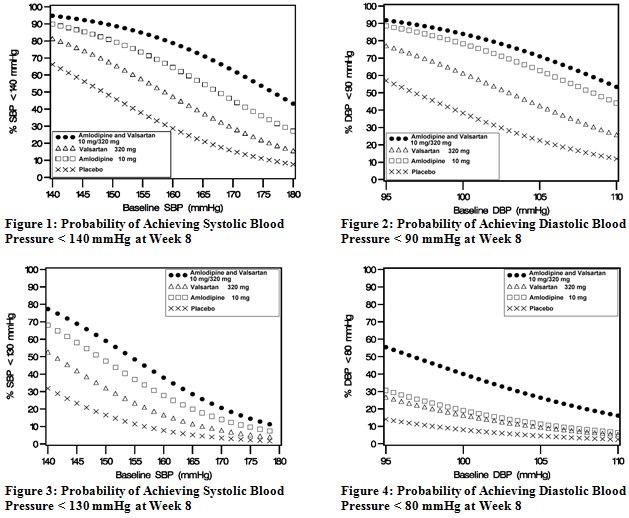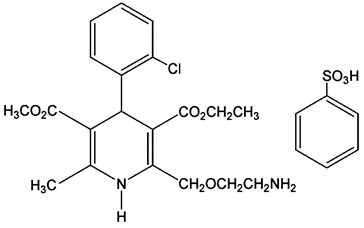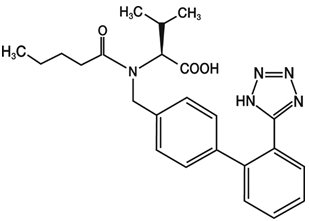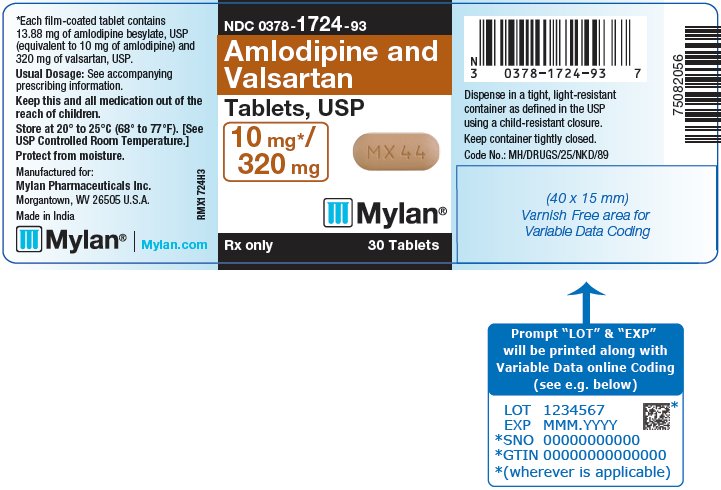Drug Catalog - Product Detail
AMLODIPINE BESYLATE/VALSARTAN TB 10/320MG 30
| NDC | Mfr | Size | Str | Form |
|---|---|---|---|---|
| 00378-1724-93 | MYLAN | 30 | 10-320MG | TABLET |
PACKAGE FILES







Generic Name
AMLODIPINE AND VALSARTAN
Substance Name
AMLODIPINE BESYLATE
Product Type
HUMAN PRESCRIPTION DRUG
Route
ORAL
Application Number
ANDA090483
Description
11 DESCRIPTION Amlodipine and valsartan tablets, USP are a fixed combination of amlodipine and valsartan. Amlodipine and valsartan tablets contain the besylate salt of amlodipine, a dihydropyridine calcium-channel blocker (CCB). Amlodipine besylate, USP is a white or almost white powder, slightly soluble in water and sparingly soluble in ethanol. Amlodipine besylate’s chemical name is 3-ethyl-5-methyl (4 RS )-2-[(2-aminoethoxy)methyl]-4-(2-chlorophenyl)-6-methyl-1,4-dihydropyridine-3,5-dicarboxylate benzenesulfonate; its structural formula is: Its molecular formula is C 20 H 25 ClN 2 O 5 •C 6 H 6 O 3 S and its molecular weight is 567.1. Valsartan is a nonpeptide, orally active, and specific angiotensin II antagonist acting on the AT 1 receptor subtype. Valsartan, USP is a white to almost white amorphous powder, soluble in ethanol and methanol and slightly soluble in water. Valsartan’s chemical name is N -[ p -( o -1 H -tetrazol-5-ylphenyl)benzyl]- N -valeryl- L -valine; its structural formula is: Its molecular formula is C 24 H 29 N 5 O 3 and its molecular weight is 435.52. Amlodipine and valsartan tablets are formulated in 4 strengths for oral administration with a combination of amlodipine besylate (6.94 mg or 13.88 mg, equivalent to 5 mg or 10 mg of amlodipine respectively), with 160 mg, or 320 mg of valsartan providing for the following available combinations: 5/160 mg, 10/160 mg, 5/320 mg, and 10/320 mg. The inactive ingredients for all strengths of the tablets are colloidal silicon dioxide, crospovidone, hypromellose, magnesium stearate, microcrystalline cellulose, polyethylene glycol, red iron oxide, sodium starch glycolate (potato), talc, titanium dioxide and yellow iron oxide. Meets USP Dissolution Test 3. Amlodipine Besylate Structural Formula Valsartan Structural Formula
How Supplied
16 HOW SUPPLIED/STORAGE AND HANDLING Amlodipine and Valsartan Tablets, USP are available containing amlodipine besylate, USP (6.94 mg or 13.88 mg, equivalent to 5 mg or 10 mg of amlodipine respectively) with 160 mg or 320 mg of valsartan, USP providing for the following available combinations: 5 mg/160 mg, 10 mg/160 mg, 5 mg/320 mg or 10 mg/320 mg. The 5 mg/160 mg tablets are light orange, film-coated, oval, unscored tablets debossed with MX1 on one side of the tablet and blank on the other side. They are available as follows: NDC 0378-1721-93 bottles of 30 tablets The 10 mg/160 mg tablets are tan, film-coated, oval, unscored tablets debossed with MX2 on one side of the tablet and blank on the other side. They are available as follows: NDC 0378-1722-93 bottles of 30 tablets The 5 mg/320 mg tablets are orange, film-coated, capsule-shaped, unscored tablets debossed with MX43 on one side of the tablet and blank on the other side. They are available as follows: NDC 0378-1723-93 bottles of 30 tablets The 10 mg/320 mg tablets are light orange, film-coated, capsule-shaped, unscored tablets debossed with MX44 on one side of the tablet and blank on the other side. They are available as follows: NDC 0378-1724-93 bottles of 30 tablets Store at 20° to 25°C (68° to 77°F). [See USP Controlled Room Temperature.] Protect from moisture. Dispense in a tight, light-resistant container as defined in the USP using a child-resistant closure.
Indications & Usage
1 INDICATIONS AND USAGE Amlodipine and valsartan is the combination tablet of amlodipine, a dihydropyridine calcium channel blocker (DHP CCB), and valsartan, an angiotensin II receptor blocker (ARB). Amlodipine and valsartan tablets are indicated for the treatment of hypertension, to lower blood pressure: • In patients not adequately controlled on monotherapy ( 1 ) • As initial therapy in patients likely to need multiple drugs to achieve their blood pressure goals ( 1 ) Lowering blood pressure reduces the risk of fatal and nonfatal cardiovascular events, primarily strokes and myocardial infarctions. 1.1 Hypertension Amlodipine and valsartan tablets are indicated for the treatment of hypertension, to lower blood pressure. Lowering blood pressure reduces the risk of fatal and nonfatal cardiovascular events, primarily strokes and myocardial infarctions. These benefits have been seen in controlled trials of antihypertensive drugs from a wide variety of pharmacologic classes, including amlodipine and the angiotensin II receptor blocker (ARB) class to which valsartan principally belongs. There are no controlled trials demonstrating risk reduction with amlodipine and valsartan tablets. Control of high blood pressure should be part of comprehensive cardiovascular risk management, including, as appropriate, lipid control, diabetes management, antithrombotic therapy, smoking cessation, exercise, and limited sodium intake. Many patients will require more than 1 drug to achieve blood pressure goals. For specific advice on goals and management, see published guidelines, such as those of the National High Blood Pressure Education Program’s Joint National Committee on Prevention, Detection, Evaluation, and Treatment of High Blood Pressure (JNC). Numerous antihypertensive drugs, from a variety of pharmacologic classes and with different mechanisms of action, have been shown in randomized controlled trials to reduce cardiovascular morbidity and mortality, and it can be concluded that it is blood pressure reduction, and not some other pharmacologic property of the drugs, that is largely responsible for those benefits. The largest and most consistent cardiovascular outcome benefit has been a reduction in the risk of stroke, but reductions in myocardial infarction and cardiovascular mortality also have been seen regularly. Elevated systolic or diastolic pressure causes increased cardiovascular risk, and the absolute risk increase per mmHg is greater at higher blood pressures, so that even modest reductions of severe hypertension can provide substantial benefit. Relative risk reduction from blood pressure reduction is similar across populations with varying absolute risk, so the absolute benefit is greater in patients who are at higher risk independent of their hypertension (for example, patients with diabetes or hyperlipidemia), and such patients would be expected to benefit from more aggressive treatment to a lower blood pressure goal. Some antihypertensive drugs have smaller blood pressure effects (as monotherapy) in black patients, and many antihypertensive drugs have additional approved indications and effects (e.g., on angina, heart failure, or diabetic kidney disease). These considerations may guide selection of therapy. Amlodipine and valsartan tablets are indicated for the treatment of hypertension. Amlodipine and valsartan tablets may be used in patients whose blood pressure is not adequately controlled on either monotherapy. Amlodipine and valsartan tablets may also be used as initial therapy in patients who are likely to need multiple drugs to achieve their blood pressure goals. The choice of amlodipine and valsartan tablets as initial therapy for hypertension should be based on an assessment of potential benefits and risks including whether the patient is likely to tolerate the lowest dose of amlodipine and valsartan tablets. Patients with stage 2 hypertension (moderate or severe) are at a relatively higher risk for cardiovascular events (such as strokes, heart attacks, and heart failure), kidney failure and vision problems, so prompt treatment is clinically relevant. The decision to use a combination as initial therapy should be individualized and should be shaped by considerations such as baseline blood pressure, the target goal and the incremental likelihood of achieving goal with a combination compared to monotherapy. Individual blood pressure goals may vary based upon the patient’s risk. Data from the high-dose multifactorial study [see Clinical Studies (14) ] provide estimates of the probability of reaching a blood pressure goal with amlodipine and valsartan tablets compared to amlodipine or valsartan monotherapy. The figures below provide estimates of the likelihood of achieving systolic or diastolic blood pressure control with amlodipine and valsartan tablets 10/320 mg, based upon baseline systolic or diastolic blood pressure. The curve of each treatment group was estimated by logistic regression modeling. The estimated likelihood at the right tail of each curve is less reliable due to small numbers of subjects with high baseline blood pressures. For example, a patient with a baseline blood pressure of 160/100 mmHg has about a 67% likelihood of achieving a goal of < 140 mmHg (systolic) and 80% likelihood of achieving < 90 mmHg (diastolic) on amlodipine alone, and the likelihood of achieving these goals on valsartan alone is about 47% (systolic) or 62% (diastolic). The likelihood of achieving these goals on amlodipine and valsartan tablets rises to about 80% (systolic) or 85% (diastolic). The likelihood of achieving these goals on placebo is about 28% (systolic) or 37% (diastolic). Amlodipine and Valsartan Figures 01 - 04
Dosage and Administration
2 DOSAGE AND ADMINISTRATION General Considerations: • Majority of effect attained within 2 weeks ( 2.1 ) • May be administered with other antihypertensive agents ( 2.1 ) Hypertension: • May be used as add-on therapy for patients not controlled on monotherapy ( 2.2 ) • Patients who experience dose-limiting adverse reactions on monotherapy may be switched to amlodipine and valsartan tablets containing a lower dose of that component ( 2.2 ) • May be substituted for titrated components ( 2.3 ) • When used as initial therapy: Initiate with 5/160 mg, then titrate upwards as necessary to a maximum of 10/320 mg once daily ( 2.4 ) 2.1 General Considerations Dose once daily. The dosage can be increased after 1 to 2 weeks of therapy to a maximum of one 10/320 mg tablet once daily as needed to control blood pressure. The majority of the antihypertensive effect is attained within 2 weeks after initiation of therapy or a change in dose. Amlodipine and valsartan tablets may be administered with other antihypertensive agents. 2.2 Add-on Therapy A patient whose blood pressure is not adequately controlled with amlodipine (or another dihydropyridine calcium-channel blocker) alone or with valsartan (or another ARB) alone may be switched to combination therapy with amlodipine and valsartan tablets. A patient who experiences dose-limiting adverse reactions on either component alone may be switched to amlodipine and valsartan tablets containing a lower dose of that component in combination with the other to achieve similar blood pressure reductions. The clinical response to amlodipine and valsartan tablets should be subsequently evaluated and if blood pressure remains uncontrolled after 3 to 4 weeks of therapy, the dose may be titrated up to a maximum of 10/320 mg. 2.3 Replacement Therapy For convenience, patients receiving amlodipine and valsartan from separate tablets may instead wish to receive tablets of amlodipine and valsartan containing the same component doses. 2.4 Initial Therapy A patient may be initiated on amlodipine and valsartan tablets if it is unlikely that control of blood pressure would be achieved with a single agent. The usual starting dose is amlodipine and valsartan tablets 5/160 mg once daily in patients who are not volume-depleted.
